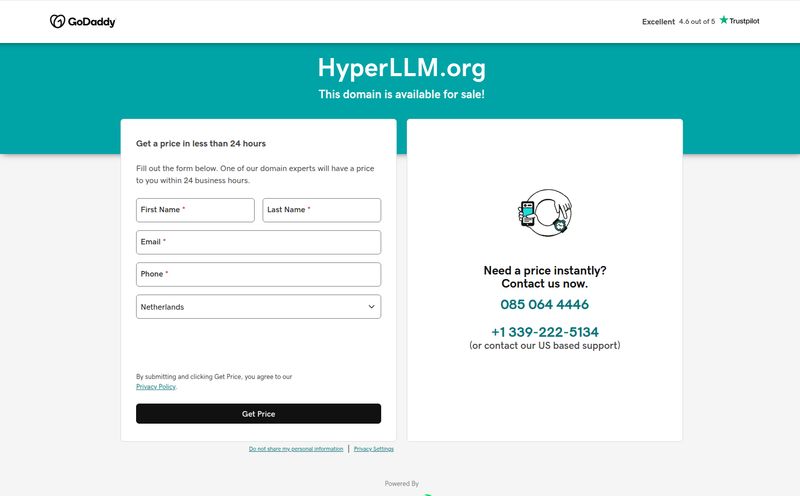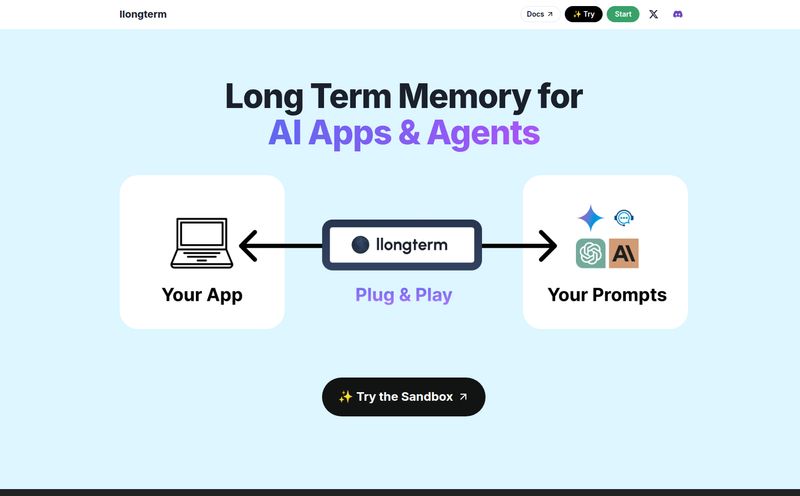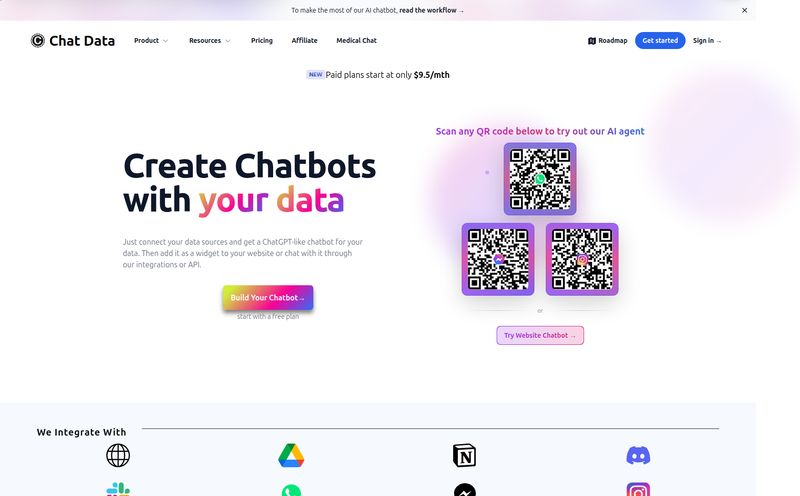If you're in marketing, SEO, or any field that touches data, you know the feeling. It’s that slow-burn panic of staring at a mountain of unstructured text—customer reviews, support tickets, social media comments, interview transcripts, you name it—and knowing there are pure gold nuggets of insight hidden in there. But who has the time to manually sift through it all? My sanity is a finite resource, you know?
For years, the process has been a soul-crushing cycle of CTRL+F, messy spreadsheets, and way too much caffeine. You try to categorize things, but the language is inconsistent. You try to pull out names or dates, but the formats are all over the place. It's like trying to assemble IKEA furniture using only a spoon. You might get there eventually, but you'll probably cry once or twice.
So, when a tool pops up on my radar that claims to be an “AI-powered text parser,” my ears perk up. I’ve seen a lot of AI hype, and frankly, a lot of it is just smoke and mirrors. But this one, AI Textraction, caught my eye over on RapidAPI. It promised to extract custom entities from messy text. My interest was officially piqued.

Visit AI Textraction
So, What Is AI Textraction Anyway?
Okay, let's break it down without the marketing fluff. Imagine you have a super-smart, ridiculously fast intern. You can hand this intern a 100-page document and say, “Hey, go through this and highlight every time a customer mentions a specific feature they want, find all the invoice numbers, and also give me a one-sentence summary of each person's main complaint.” And the intern just... does it. Instantly.
That's basically AI Textraction. It’s an API (Application Programming Interface, for the uninitiated) that you feed text to. You define what you’re looking for—these are your 'entities'—and the AI model reads the text and pulls out the information for you. This isn't just simple keyword matching. It claims to understand context, which is the holy grail of text analysis. It can grab concrete things like prices, emails, and phone numbers, but it can also identify more abstract concepts like the main topic of a paragraph or a medical diagnosis. The potential applications started immediately spinning in my head.
My First Impressions and The Standout Features
I’ve played around with a lot of APIs, and some are... let's just say, less than intuitive. Getting started with AI Textraction via RapidAPI was surprisingly straightforward. But the interface isn't the product, the output is. Here’s what stood out to me.
Custom Entity Extraction is the Real MVP
This is the absolute core of the tool, and where it shines. Most parsers come with a pre-set list of things they can find: names, locations, organizations. That’s useful, but often not enough. AI Textraction lets you define your own.
For an SEO, this is huge. You could feed it a bunch of competitor blog posts and ask it to extract “main keywords,” “statistical claims,” and “internal link targets.” Or sift through product reviews to pull out “mentions of price,” “comparisons to competitor X,” and “reported bugs.” The flexibility is its biggest strength. You're not limited by the developer's imagination, only your own.
It Can Handle The Long Stuff
A lot of text analysis tools I've used in the past have a nasty character limit. They're fine for tweets or short comments, but feed them a full-length article or a detailed report and they just choke. AI Textraction supports up to 50,000 characters. That’s a game-changer. It means you can analyze meaty documents, research papers, or those ridiculously long customer support chat logs without having to chop them into a dozen pieces first. Thank goodness.
It Speaks More Than Just English
The documentation also boasts multi-language support. I haven't tested this as extensively, but in a global market, being able to run the same analysis on customer feedback from Spain, Germany, or France without building a separate process for each is a massive time-saver. It’s a feature that shows they're thinking about real-world business needs.
The Good, The Bad, and The AI
No tool is perfect, right? After the initial excitement, you have to look at it with a critical eye. Here’s my honest breakdown.
What I Really Liked
The power and flexibility are undeniable. Being able to define exactly what I’m looking for in a sea of text feels like a superpower. For anyone doing data-driven content strategy or market research, this can automate what used to be days of manual labor. I also love that its built on a powerful AI model; you can feel that it's doing more than just a glorified search-and-replace. It’s trying to understand.
A Few Words of Caution
Now for the reality check. The platform itself states that the output can contain statistical errors and that accuracy isn’t guaranteed. This isn’t a flaw unique to AI Textraction; it’s the nature of current AI. It’s incredibly good, but not infallible. You can't just pipe the output directly into a mission-critical report without a human glance-over. Think of it as a tool that gets you 95% of the way there, and a human expert needs to handle the last 5%. Also, the mention of “limited service availability” gives me slight pause, though I haven’t run into any issues myself. It’s just something to be aware of if you plan to build a major business process around it.
Let's Talk Money: The AI Textraction Pricing Tiers
Price is always a major factor. So, how much will this magic intern cost you? The pricing structure is actually pretty accommodating, with a few different levels.
"Finding the right data is like panning for gold in a river of text. A tool like this doesn't create the gold, but it can sure as heck give you a much better pan."
Here’s a simplified look at their plans (as of this writing):
- Basic Plan: This one’s free! You get 100 requests a month. This is perfect for testing, small projects, or just satisfying your curiosity. I always appreciate a generous free tier. It shows confidence in the product.
- Pro Plan: For $5.00 a month, you get 500 requests, with additional ones costing a penny each. This is a great step up for freelancers or small businesses who have a regular but not massive need.
- Ultra Plan: At $100.00 a month, you jump to 12,500 requests, with overage at $0.008 per request. This is for serious users, probably developers integrating this into an application or marketers with significant data streams.
- Mega Plan: And then there's the big one. For $1,500.00 a month, you get a whopping 200,000 requests. This is clearly aimed at enterprise-level clients who are processing immense amounts of text data daily.
The jump from Ultra to Mega is substantial, which clearly segments their target audience. But for most individuals and small-to-medium businesses, the Free and Pro plans are incredibly accessible.
So, Who Is This Tool Really For?
This isn't a tool for everyone. If you’re a blogger who just needs to read your comments, this is overkill. But if you’re one of the following, you should pay attention:
- Data Analysts & Researchers: This is your bread and butter. Automating the initial sift of qualitative data is a dream.
- Marketers & SEOs: Imagine analyzing thousands of SERP results, customer reviews, or survey responses for trends and opportunities. Yep.
- Developers: Anyone building an app that needs to understand user input—from a chatbot to a complaint submission form—could build some seriously cool features with this.
- Business Owners: If you're trying to get a handle on the voice of your customer from support emails and reviews, this could be your key to unlocking those insights at scale.
Frequently Asked Questions about AI Textraction
I had a few questions myself, so here are some answers you might be looking for.
Can AI Textraction understand really complex requests?
It’s surprisingly capable. Instead of just asking for “dates,” you can specify things like “appointment date” or “due date,” and it uses the context to find the right one. The more specific your definition (the prompt, in AI terms), the better your results will be. It takes a little experimentation.
Do I need to be a developer to use AI Textraction?
Yes and no. Because it's an API, some technical comfort is needed. However, platforms like RapidAPI have a user interface that lets you test the API directly in your browser without writing any code. So you can paste in your text, define your entities, and see the results right away. To integrate it into your own website or application, you'd need a developer.
How is this better than just using CTRL+F?
Oh, it’s a whole different universe. CTRL+F finds exact character matches. It can’t tell you that “it was too expensive” and “the price was too high” mean the same thing. It can't extract a concept like “customer sentiment.” AI Textraction understands semantics and context, not just strings of letters.
What kind of unstructured text works best?
In my experience, it works well on a variety of texts, from formal reports to casual customer reviews. The key is that the information you're looking for needs to be actually present in the text. The AI is a brilliant reader, but it’s not a mind reader.
Is my data safe when using this API?
When using any third-party API, this is a valid concern. Communications with the RapidAPI platform are typically encrypted (HTTPS). However, you should always review the API provider's and RapidAPI's terms of service and privacy policy, especially if you're processing sensitive or personally identifiable information (PII).
My Final Verdict on AI Textraction
So, is AI Textraction the magic bullet for all your data woes? No, of course not. No tool is. But it is an incredibly powerful and impressively accessible life raft for anyone drowning in a sea of unstructured text. It's a specialized instrument that does one thing—custom entity extraction—exceptionally well.
It won't replace human analysis, but it will augment it, taking care of the most tedious, time-consuming parts of the job. It lets you skip the grunt work and get straight to the strategic thinking. And in our line of work, that’s not just a time-saver; its a competitive advantage. For the price of free to get started, it’s absolutely worth taking for a spin.
References and Sources
- AI Textraction on RapidAPI: https://rapidapi.com/textractionai/api/ai-textraction
- Pricing Information: https://rapidapi.com/textractionai/api/ai-textraction/pricing



